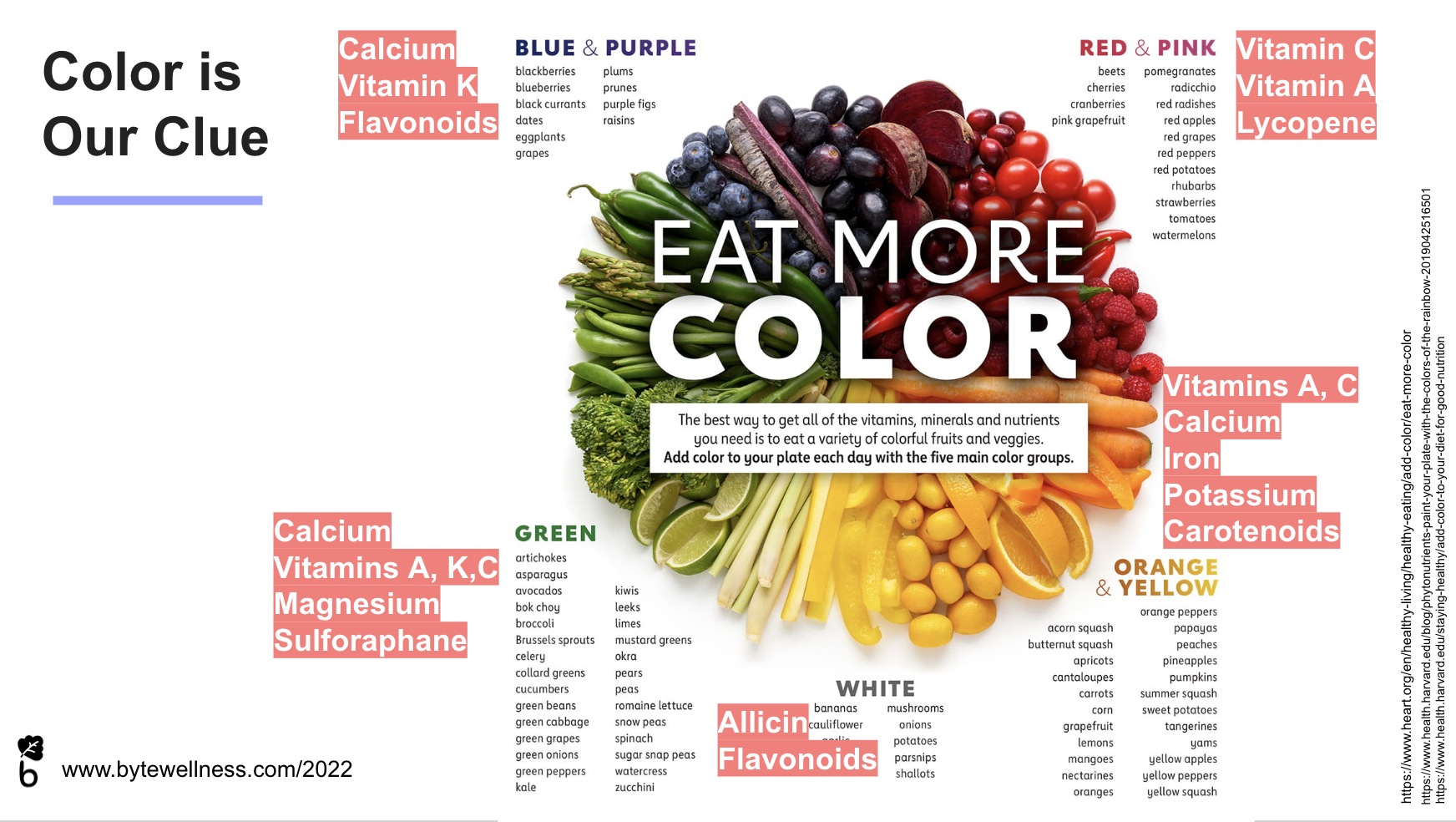It's The Colors! Finding Plant Magic in the Chipotle Vegan Bowl
Hi Byte Wellness Fam!
What does it look like where you are in the world? It’s Spring here in Chicago, and we’re (barely) starting to see colors outdoors. We’ve got green buds on the trees, yellow and pink flowers on bushes. It feels like nature is coming alive again after a very long winter. Ironically, while these plant colors symbolize new life, the chemicals responsible for the colors play a huge role in human life.
In food, these color chemicals are called PHYTONUTRIENTS.
We talked about all this in our #ByteWellnessWednesday workshop and the Daily Wellness Text Thread this week. Check out the recording in our private online community (the Phyte Well Healing Circle).
Image adapted from https://www.heart.org/en/healthy-living/healthy-eating/add-color/eat-more-color
Phytonutrients are the nutritional building blocks found in plants (not animals). They’re probably the main reason why whole food plant-heavy diets are so strongly linked to health in every category. Still, there’s still so much that science hasn’t discovered about them. That’s why I call them “plant magic”.
Phytonutrients feature in the “C” of our ABCs of Making Meatless Meals:
A for Appetite (Use a combination or fiber, fat and protein to feel full and satisfied)
B for Balanced Nutrition (Use the Balanced Plate as a guideline to combine food groups and portion sizes)
C for Colors (Eat the rainbow to get a variety of phytonutrients)
Plant magic (phytonutrients) in our Chipotle Vegan Bowl
Where do we find plant magic (phytonutrients) in our Chipotle Vegan Bowl?
You can read more about phytonutrients, their connection to food colors and their impact on our health here.
Meanwhile, let’s see what research has to say about some of the plant magic (phytonutrients) you’ll run into by eating the rainbow.
Red Foods:
From our Chipotle Vegan Bowl Recipe: Red bell peppers, Chili pepper, Tomatoes
Red foods are generally rich in the carotenoid lycopene, a strong anti-oxidant that promotes heart health and anti-aging.
Blue/Purple Foods:
From our Chipotle Vegan Bowl Recipe: Red Onions
Blue/Purple foods generally have another type of antioxidant polyphenol called anthocyanins. Anthocyanin-containing foods are linked to better cholesterol profiles and a lower risk of heart disease in humans.
Green Foods:
From our Chipotle Vegan Bowl Recipe: Spinach, Green Bell Pepper, Jalapeño, Cilantro, Avocado
Green foods might have anti-cancer chemicals called isocynates, indoles and sulfurophane that have been shown to block cancer-causing agents. These chemicals are especially rich in cruciferous veggies like kale, brussels sprouts and cabbage.
Yellow Foods:
From our Chipotle Vegan Bowl Recipe: Yellow Bell Pepper
Yellow foods generally have a class of polyphenols called carotenoids. Some carotenoids turn into vitamin A (a source of immune support and vision health). Others promote eye health, linked to lower risk of cataracts and age-related macular degeneration.
White/Brown Foods:
From our Chipotle Vegan Bowl Recipe: Garlic, Black Beans, Quinoa
White and brown foods are generally rich in sulfur-based compounds like the anti-inflammatory agent allicin found in the garlic and onion family. They also tend to deliver anti-oxidant flavonoids like quercetin (known for its anti-tumor potential).
Check Phytonutrients for Yourself
Wondering how you can learn more about which phytonutrients are in your food? Check the Phenol Explorer database to find an huge list of international foods and their polyphenol content. Now, polyphenols are only one class of phytonutrients (grouped by their characteristic ring structure). Not all phytonutrients are polyphenols.
Remember allicin? Allicin is the powerful anti-inflammatory compound that’s formed when you cut garlic and onions. That’s not a polyphenol. So the Phenol Explorer database won’t show that the garlic we used in our Chipotle Vegan Bowl has allicin in it. But it does show the phytonutrients that happen to be polyphenols: lots of lignans.
Lignans are a type of chemical called phyto-estrogens (plant-estrogens). They’re known for their anti-inflammatory, anti-oxidant and anti-tumor activity. They’re also linked with lower risk of heart disease.
Important note: Most of these anti-tumor studies have shown the effect of lignans in mice or on human cells in a test tube. There’s a lot more research needed to understand how lignans could be used as cancer treatment in humans.
Data from http://phenol-explorer.eu/foods
Discussion Question:
Which veggies do you love? Why?
Go ahead, say it with your chest! This question helps us probe our palate. Maybe you didn’t like many vegetables growing up. Maybe you’ve only recently opened up to appreciating their flavor. Let’s name the ones we really enjoy and recognize that there are almost certainly other veggies out there share the characteristics of the ones we love- whether it’s flavor, color or texture. There’s always more veggie love to tap into : )
Jump into the private community or the blog comments or the text thread to let me know what’s YOUR fave veggie.
Happy Healthy Living,
Dr. Wuse


